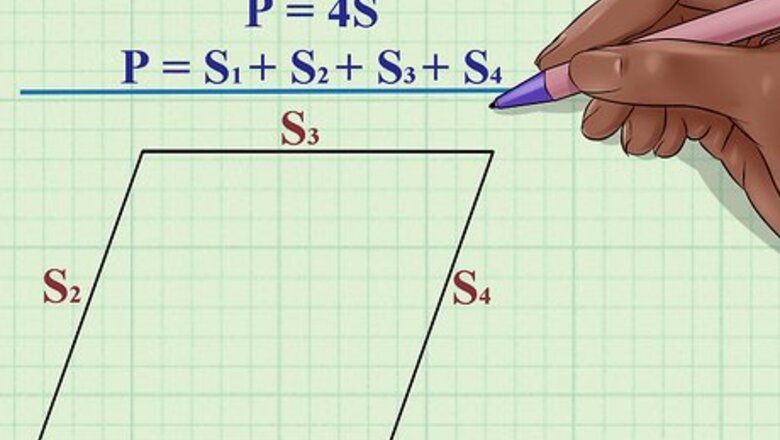
views
X
Research source
These properties allow for numerous methods for finding the perimeter. Since all four sides of a rhombus are of equal length, finding the perimeter is possible when one side length is known. However, using geometry and trigonometry, it is also possible to find the perimeter even if you do not know the lengths of any sides of the rhombus.
Using Side Length
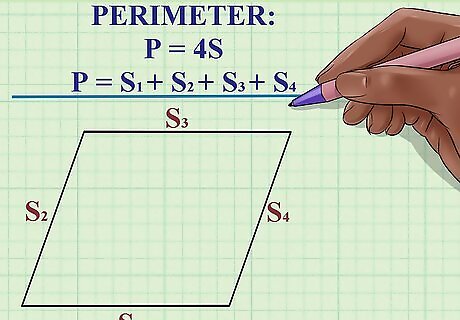
Set up the formula for perimeter of a rhombus. Since, by definition, all four sides of a rhombus are the same length, the formula is P = 4 S {\displaystyle P=4S} P=4S, where P {\displaystyle P} P equals the perimeter, and S {\displaystyle S} S equals the length of one side. You could also use the formula P = S + S + S + S {\displaystyle P=S+S+S+S} P=S+S+S+S to find the perimeter, since the perimeter of any polygon is the sum of all its sides. If you know that not all sides are the same length, then you are not working with a rhombus, and you cannot use this formula. If you don’t know the length of any side of the rhombus, you cannot use this method. A square is a special type of rhombus, with four 90-degree angles.
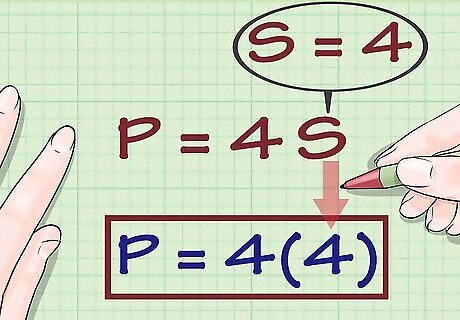
Plug in the side length of the rhombus. Make sure you are substituting for the variable S {\displaystyle S} S. For example, if you know one side of the rhombus is 4 meters long, your formula will look like this: P = 4 ( 4 ) {\displaystyle P=4(4)} P=4(4).
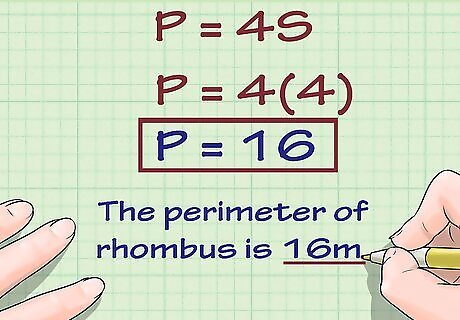
Solve for P {\displaystyle P} P. To do this, multiply S {\displaystyle S} S by 4. For example: P = 4 ( 4 ) {\displaystyle P=4(4)} P=4(4) P = 16 {\displaystyle P=16} P=16 So, the perimeter of the rhombus is 16 m {\displaystyle 16m} 16m.
Using Length of Diagonals
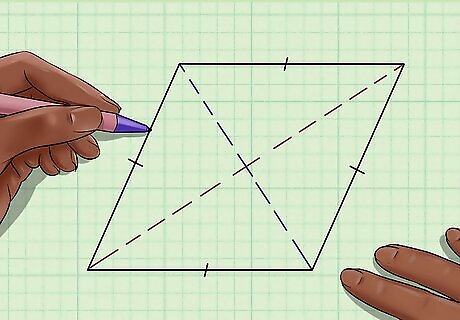
Notice that the two diagonals of your rhombus create four congruent triangles. Outline one of these triangles. You will use it to find the length of one side of the rhombus. Since the triangles are congruent, it doesn’t matter which one you outline.
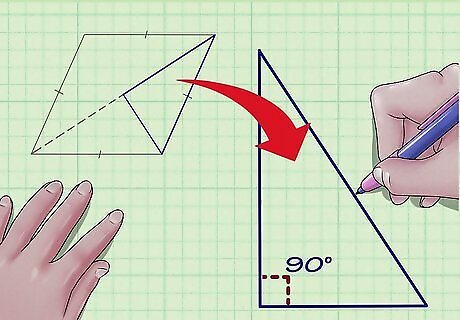
Identify the 90 degree angle of your triangle. The two diagonals of a rhombus are perpendicular, so the central angle of your triangle will be 90 degrees.

Label the hypotenuse of your triangle. The hypotenuse is the side opposite a 90 degree angle.Traditionally, the hypotenuse is labeled c {\displaystyle c} c. The hypotenuse of your triangle is one side of the rhombus. So, if you find the length of c {\displaystyle c} c, you will know the length of one side of the rhombus.
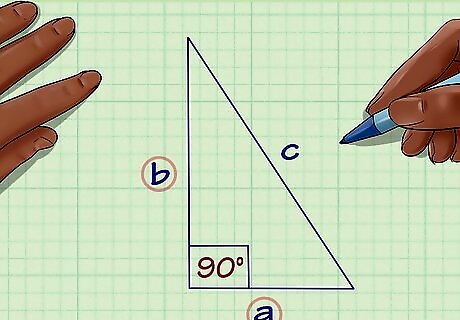
Label the other two sides of your triangle. Traditionally, these are labeled a {\displaystyle a} a and b {\displaystyle b} b.
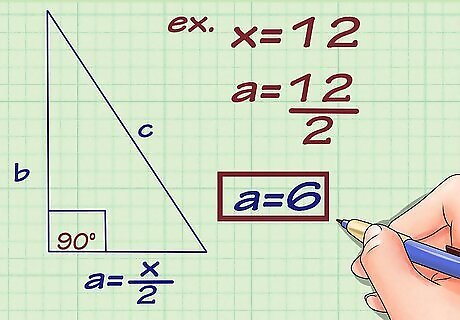
Find the length of side a {\displaystyle a} a. To do this, divide the length of the diagonal that a {\displaystyle a} a runs along by 2. Label the side length on your triangle. Since the diagonals of a rhombus bisect each other, you know that the length on either side of their intersection will be equal. Since side a {\displaystyle a} a is half the length of the diagonal, you can find its length by dividing the diagonal length in half. For example, if side a {\displaystyle a} a runs along a diagonal that is 12 meters long, you can find the length of side a {\displaystyle a} a by calculating: a = 12 2 {\displaystyle a={\frac {12}{2}}} a={\frac {12}{2}} a = 6 {\displaystyle a=6} a=6
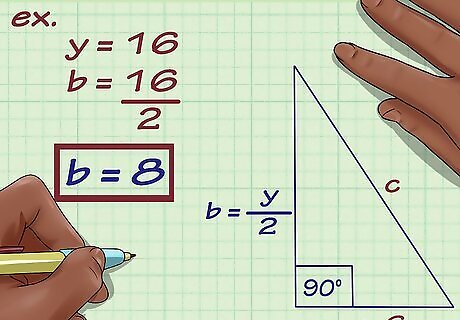
Find the length of side b {\displaystyle b} b. To do this, divide the length of the diagonal that b {\displaystyle b} b runs along by 2. Label the side length on your triangle. For example, if side b {\displaystyle b} b runs along a diagonal that is 16 meters long, you can find the length of side b {\displaystyle b} b by calculating: b = 16 2 {\displaystyle b={\frac {16}{2}}} b={\frac {16}{2}} b = 8 {\displaystyle b=8} b = 8

Set up the Pythagorean Theorem. The theorem states that a 2 + b 2 = c 2 {\displaystyle a^{2}+b^{2}=c^{2}} a^{{2}}+b^{{2}}=c^{{2}}. This is a basic geometric formula for finding the side lengths of a right triangle.
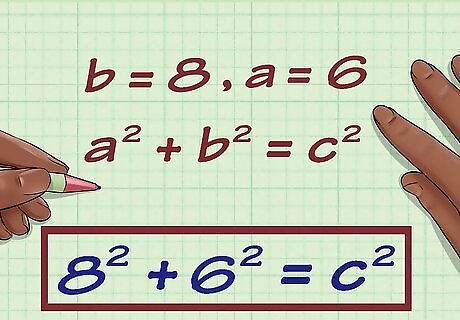
Plug in the known side lengths of your triangle into the Pythagorean Theorem. Make sure you substitute for a {\displaystyle a} a and b {\displaystyle b} b, but the order doesn’t matter due to the commutative property. For example, if a = 6 {\displaystyle a=6} a=6 and b = 8 {\displaystyle b=8} b = 8, your equation will look like this: 6 2 + 8 2 = c 2 {\displaystyle 6^{2}+8^{2}=c^{2}} 6^{{2}}+8^{{2}}=c^{{2}}.
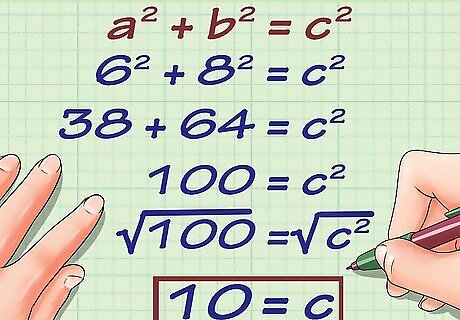
Solve for c {\displaystyle c} c. To do this, you need to square a {\displaystyle a} a and b {\displaystyle b} b, add, then find the square root of the sum. For example: 6 2 + 8 2 = c 2 {\displaystyle 6^{2}+8^{2}=c^{2}} 6^{{2}}+8^{{2}}=c^{{2}} 36 + 64 = c 2 {\displaystyle 36+64=c^{2}} 36+64=c^{{2}} 100 = c 2 {\displaystyle 100=c^{2}} 100=c^{{2}} 100 = c 2 {\displaystyle {\sqrt {100}}={\sqrt {c^{2}}}} {\sqrt {100}}={\sqrt {c^{{2}}}} 10 = c {\displaystyle 10=c} 10=c
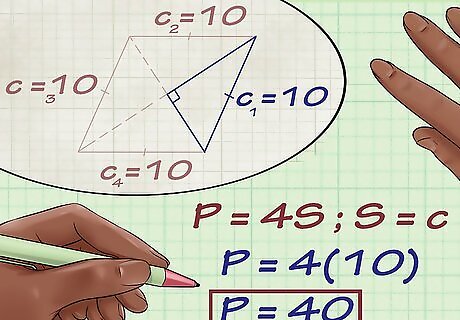
Multiply c {\displaystyle c} c by four. Since the hypotenuse is also the side of the rhombus, to find the perimeter of the rhombus, you need to plug the value of c {\displaystyle c} c into the formula for the perimeter of a rhombus, which is P = 4 S {\displaystyle P=4S} P=4S, where s {\displaystyle s} s equals the length of one side of the rhombus. In this case, it is the same value that we found for c {\displaystyle c} c. For example: P = 4 S {\displaystyle P=4S} P=4S P = 4 ( 10 ) {\displaystyle P=4(10)} P=4(10) P = 40 {\displaystyle P=40} P=40
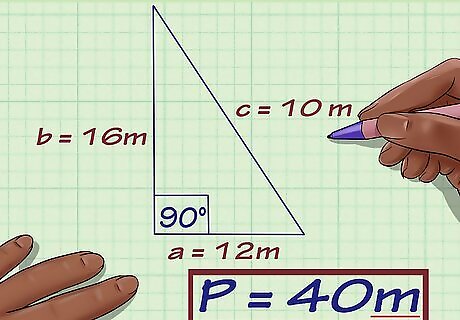
Write your final answer. Don’t forget to include the correct unit of measurement. For example, a rhombus that has diagonals measuring 12 and 16 meters long has a perimeter of 40 meters.
Using One Diagonal and One Angle
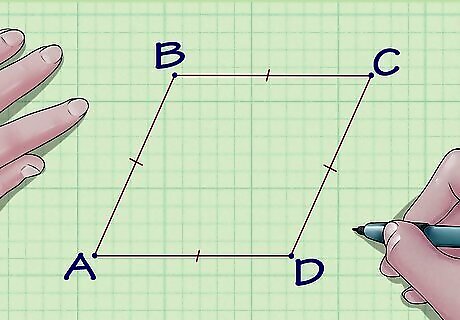
Label the vertices of your rhombus, if they are not already labeled. It doesn’t matter which variables you give them. The vertices (singular vertex) are the corners of the rhombus. For example, you might label the vertices A {\displaystyle A} A, B {\displaystyle B} B, C {\displaystyle C} C, and D {\displaystyle D} D.
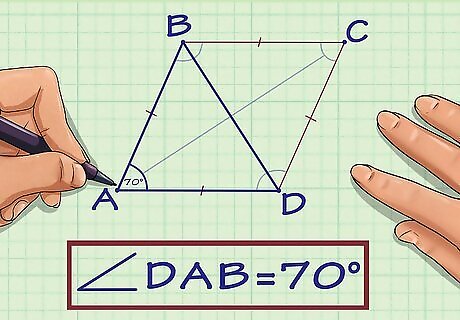
Notice that the two diagonals of your rhombus create four congruent triangles. Outline one of these triangles. You will use it to find the length of one side of the rhombus. Since the triangles are congruent, it doesn’t matter which one you outline; however, for simplicity you should outline a triangle that shares a known angle of the rhombus. For example, I know that angle D A B {\displaystyle DAB} DAB of the rhombus is 70 degrees, so I would outline a triangle that includes point A.
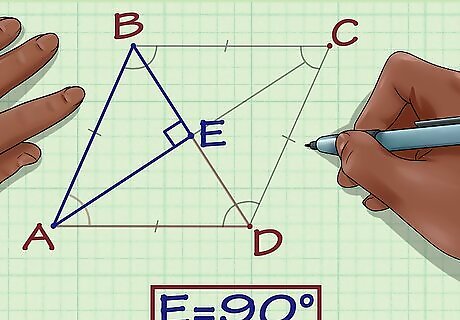
Identify the 90 degree angle of your triangle. The two diagonals of a rhombus are perpendicular, so the central angle of your triangle will be 90 degrees.If this angle is not already labeled, label it E {\displaystyle E} E.
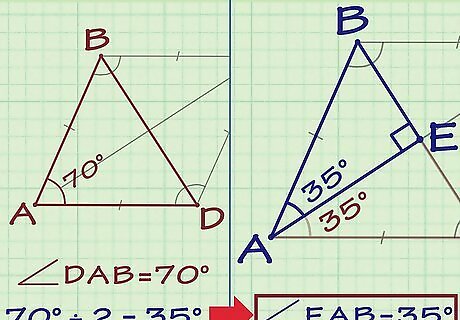
Determine the measurement of angle E A B {\displaystyle EAB} EAB. Remember that the diagonals of a rhombus bisect its vertices. So, if you know the measurement of angle D A B {\displaystyle DAB} DAB of the rhombus, divide it in half to find the measurement of angle E A B {\displaystyle EAB} EAB of the triangle. Label the degrees for this angle on your triangle. This method will not work if you do not know the measurement of at least one vertex of your rhombus. For example, you know angle D A B {\displaystyle DAB} DAB of the rhombus is 70 degrees, so the angle E A B {\displaystyle EAB} EAB of the triangle is half that, or 35 degrees.
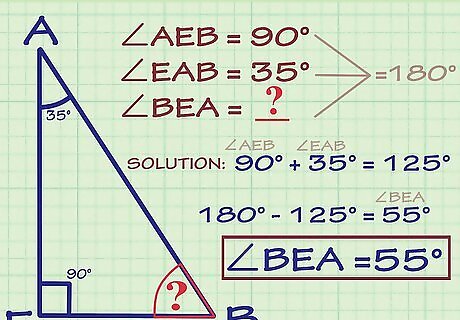
Determine the measurement of the missing angle. Remember, the interior degrees of a triangle will add up to 180. So, if you know the measurement of two angles, you can subtract to find the measurement of the third angle. Label the degrees for this angle on your triangle. For example, you know that angle A E B {\displaystyle AEB} AEB is 90 degrees, and angle E A B {\displaystyle EAB} EAB is 35 degrees. To find the third angle, sum the two angles you already know, then subtract that sum from 180. 90 + 35 = 125 {\displaystyle 90+35=125} 90+35=125 180 − 125 = 55 {\displaystyle 180-125=55} 180-125=55So, the measurement of angel A B E {\displaystyle ABE} ABE is 55 degrees.

Determine the length of one side of your triangle. To do this, divide the length of the diagonal that the side runs along by 2. Label the side length on your triangle. Since the diagonals of a rhombus bisect each other, you know that the length on either side of their intersection will be equal. This method will not work if you do not know the length of at least one diagonal of your rhombus. For example, if you know that diagonal A C {\displaystyle AC} AC is 16 centimeters, you can divide 16 in half to find the length of side A E {\displaystyle AE} AE of your triangle. 16 ÷ 2 = 8 {\displaystyle 16\div 2=8} 16\div 2=8, so side A E {\displaystyle AE} AE is 8 c m {\displaystyle 8cm} 8cm.
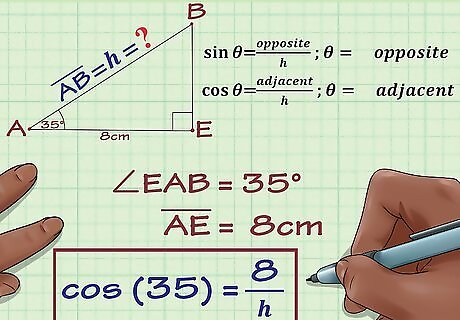
Set up a sine or cosine ratio. Whether you use sine or cosine will depend on which side and angle measurements of your triangle you know. For more information, read Use Right Angled Trigonometry. If you know the length of the side opposite to your angle, use sine. Set up the ratio sin ( θ ) = O p p o s i t e h {\displaystyle \sin(\theta )={\frac {Opposite}{h}}} \sin(\theta )={\frac {Opposite}{h}}, where θ {\displaystyle \theta } \theta is the measurement of the angle, “Opposite” is the length of the opposite side, and h {\displaystyle h} h is the length of the hypotenuse. If you know the length of the side adjacent to your angle, use cosine. Set up the ratio cos ( θ ) = A d j a c e n t h {\displaystyle \cos(\theta )={\frac {Adjacent}{h}}} \cos(\theta )={\frac {Adjacent}{h}}. Where θ {\displaystyle \theta } \theta is the measurement of the angle, “Adjacent” is the length of the adjacent side, and h {\displaystyle h} h is the length of the hypotenuse. For example, if you know that angle E A B {\displaystyle EAB} EAB of your triangle is 35 degrees, and the adjacent side is 8 centimeters, you should use cosine: cos ( 35 ) = 8 h {\displaystyle \cos(35)={\frac {8}{h}}} \cos(35)={\frac {8}{h}}

Solve the ratio to find the length of the hypotenuse. The length of the hypotenuse is also the length of one side of your rhombus, so you need this measurement to find the perimeter of the rhombus. For example: cos ( 35 ) = 8 h {\displaystyle \cos(35)={\frac {8}{h}}} \cos(35)={\frac {8}{h}} .819 = 8 h {\displaystyle .819={\frac {8}{h}}} .819={\frac {8}{h}} .819 h = 8 {\displaystyle .819h=8} .819h=8 .819 h .819 = 8 .819 {\displaystyle {\frac {.819h}{.819}}={\frac {8}{.819}}} {\frac {.819h}{.819}}={\frac {8}{.819}} h = 9.768 {\displaystyle h=9.768} h=9.768So, the length of the hypotenuse, side A B {\displaystyle AB} AB is about 9.768.
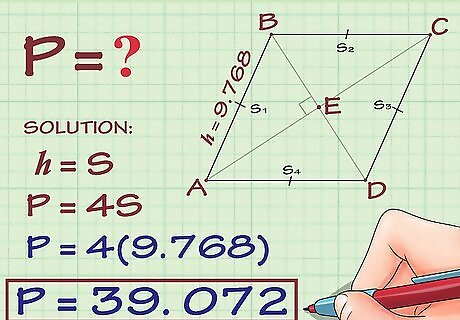
Multiply the length of the hypotenuse by four. Since the hypotenuse is also the side of the rhombus, to find the perimeter of the rhombus, you need to plug the value of h {\displaystyle h} h into the formula for the perimeter of a rhombus, which is P = 4 S {\displaystyle P=4S} P=4S, where S {\displaystyle S} S equals the length of one side of the rhombus. In this case, it is the same value that we found for h {\displaystyle h} h. For example: P = 4 S {\displaystyle P=4S} P=4S P = 4 ( 9.768 ) {\displaystyle P=4(9.768)} P=4(9.768) P = 39.072 {\displaystyle P=39.072} P=39.072
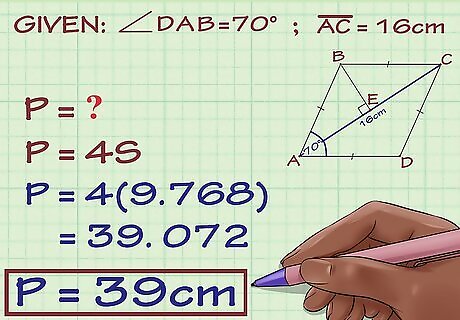
Write your final answer. Your answer will be approximate since you rounded the sine or cosine measurement. Don’t forget to include the correct unit of measurement. For example, a rhombus that has angle D A B {\displaystyle DAB} DAB measuring 70 degrees, and diagonal A C {\displaystyle AC} AC measuring 16 centimeters long, the perimeter is about 39 centimeters.















Comments
0 comment